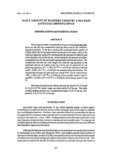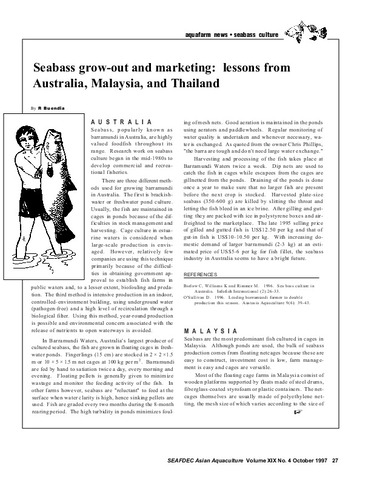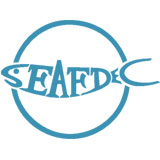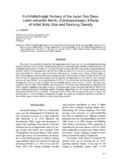Daily amount of rotifers taken by a sea bass Lates calcarifer larvae

Quan điểm/
Request this document
Ngày
1990Page views
153metadata
Hiển thị bản ghi đầy đủ mặt hàng
Share
trừu tượng
The amount of rotifers consumed by a single sea bass Lates calcarifer larva per day (R) was examined by both the direct and by the satiation-digestion methods. In the direct method, R is estimated by the number of rotifers left in the larval tanks and larval density in the tanks, while in the satiation-digestion method R is estimated by the amount of rotifers found in the digestive tract of the larvae. In both methods, the amount of rotifers consumed by the larvae increased exponentially with larval growth. The relationship between the total length (TL) and the log-log plots of the maximum amount of rotifers eaten by a larva can be expressed by the following equations; \(R=1.799 \times TL^{4.398} (r=0.975)\) for the direct method and \(R = 4.861 \times TL^{3.432} (r = 0.907)\) for the satiation-digestion method. The relationship between TL and body wet weight (BW) can be expressed as: \(BW = 2.607 \times 10^{-4} \times TL^{3.786} (r=0.960)\) for larvae smaller than 6.5 mm TL and \(BW = 15.053 \times 10^{-3} \times TL^{2.855} (r = 0.916)\) for those larger than 6.5 mm TL.
The index of satiation was almost the same for day 6(0-6), D-9 and D-12 (8.3-23%), higher range was observed in D-15 larvae. The index of daily feeding amount was comparatively higher in D-12 larvae compared to D-6, D-9 or D-15 larvae.
Suggested Citation
Kohno, H., & Duray, M. (1990). Daily amount of rotifers taken by a sea bass Lates calcarifer larvae. Philippine Journal of Science , 119(3), 247-255. http://hdl.handle.net/10862/1313
Chủ thể
Taxonomic term
Bộ sưu tập
- AQD Journal Articles [1215]
Related items
Showing items related by title, author, creator and subject.
-
Seabass grow-out and marketing: lessons from Australia, Malaysia, and Thailand
Buendia, Romeo (Aquaculture Department, Southeast Asian Fisheries Development Center, 1997) -
Optimized feeding strategies in the larviculture of the Asian seabass Lates calcarifer.
Dhert, Philippe.; Duray, Marietta; Lavens, Patrick.; Sorgeloos, Patrick. (Asian Fisheries Society, 1990)This paper reports on the progress made at the Tigbauan hatchery of SEAFDEC in the Philippines, with the larviculture of the Asian seabass Lates calcarifer when using w3-HUFA enriched Brachionus and Artemia . In view of ... -
Illuminated-cage nursery of the Asian sea bass, Lates calcarifer Bloch, (Centropomidae): effects of initial body size and stocking density
Fermin, Armando C. (Asian Fisheries Society; World Aquaculture Society - Southeast Asian Chapter, 2000)This study was conducted to determine the appropriate initial body size and the corresponding stocking density of sea bass, Lates calcarifer, during nursery rearing in illuminated cages. Hatchery-produced sea bass fry of ...





